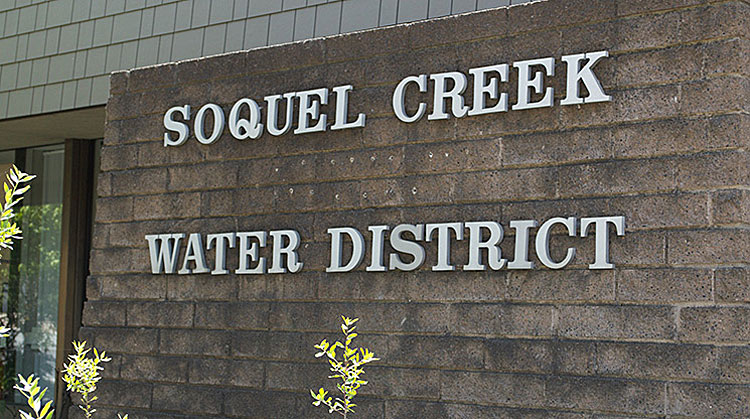The Aptos Times and the Capitola Soquel Times are devoted to the task of informing the voters rather than endorsing a particular person for the office. We asked each of the candidates to answer two questions; Rachél Lather, Bruce Jaffe and Carla Christensen responded. Here are their answers:
The Aptos area is in a time of business and residential growth. Should the Water District institute a building Moratorium until a supplemental water supply is in place?
Bruce Jaffe: Our water supply is at risk. Seawater intrusion has been detected in 3 coastal monitoring wells in the District. If the seawater continues to move inland, it will make our drinking supply salty and unusable for hundreds, if not thousands of years. We need to raise water levels at the coast to push back against seawater coming in. Pumping less or a new source of water will allow coastal water levels to rise. The District is working on getting a new source of water, but right now the only way to slow seawater intrusion is to decrease our use.
New building needs water, but the District has an innovative program, the Water Demand Offset (WDO) program, that counteracts the new water demand. The WDO program requires new building to offset new water demand with retrofits and other ways of decreasing water use that are 160% of new water use. This is a 60% increase in water that will help to decrease seawater intrusion. Over time, retrofits become less efficient, which is why the District requires 160% offset instead of 100% offset. As long as there is a viable WDO program, new building is not increasing seawater intrusion. A moratorium on new building is not needed to protect our water resource.
Carla Christensen: When I was first elected to the Board I favored a moratorium because the partnership between the District and the City of Santa Cruz to develop a desalination project had failed and we were in the middle of a severe drought.
Once on the Board I learned how effective the Water Demand Offset (WDO) Program was in promoting more efficient water use and reducing water demand. These efforts have bought us a few years to develop an environmentally sustainable, cost-effective supplemental water supply. I do not believe a moratorium is necessary at this time if we continue to lower our water demand while we identify and bring on-line a new supplemental supply that will ensure adequate quantities of safe water despite periodic droughts, and prevent seawater intrusion from contaminating the aquifer which is currently our only water source.
The District has four different approaches under investigation. Three of them involve replenishing our groundwater to ward off seawater intrusion, 1) stormwater recapture; 2) an agreement with the City of Santa Cruz to transfer rainy season runoff from North Coast streams to our Water District; 3) the District’s PureWaterSoquel project to recycle and purify treated effluent. The fourth is approach is a possible, but expensive, desalination project in Moss Landing.
Most likely more than one of these approaches will be necessary to enable significant amounts of new business and residential expansion in the long term.
Rachél Lather: I agree that any new development requires planning, and must be based on the availability of water. The District does not have the power to institute a building moratorium. That is within the jurisdiction of Santa Cruz County. The District does have the power to implement and enforce a Water Demand Offset (WDO) Program, which was adopted by the Board in 2003 and has successfully allowed development while reducing overall consumption.
The WDO Program has saved water and given us time to develop a supplemental water supply. It is critical to protect our existing water supply, all of which comes from wells, from seawater intruding into and contaminating our aquifer. This program requires all new development to offset about two times the amount of water they’re expected to use. Applicants meet their WDO requirement by paying fees and funding conservation projects. This results in a project that doesn’t worsen groundwater overdraft conditions. After 15 years of our funding conservation projects, it has become extremely difficult to find new ways to offset water use, and there is a waiting list to fund ones that are available. This has reduced the amount of development without the need to institute a moratorium.
•••
Should the Soquel Creek Water District continue to support the PureWater Soquel project?
Rachél Lather: Yes, purified recycled water is available regardless of annual rainfall and has the smallest environmental impact. It doesn’t require that we have water rights or take water needed by endangered species. During a drought we will not lose access to the water. Recycling wastewater allows water that would otherwise be sent to the ocean to be used and using it to recharge the groundwater protects against seawater intrusion. Desalination plants that would use the seawater cost more money to operate and have a larger environmental impact.
Southern California has been purifying wastewater for over 20 years and wants to expand operations because it is such a good source of water. Orange County Water District has had no health problems from recharging their aquifer with purified water. Over 20 years ago San Diego chose to continue to take water from the Colorado River (without water rights) rather than pursue purified water. San Diego now has to pursue a purified water project because the Colorado River had little water during the drought and they had limited and expensive access to the water. Learning from their mistakes is important—there are no simple answers to getting water in California.
Bruce Jaffe: Any and all sources of new water should be considered. I am a strong advocate of river water transfers from Santa Cruz. Santa Cruz is not able to transfer water to Soquel Creek Water District during droughts or even when rainfall is low. There are water rights issues with transferring large quantities of water. Water transfer will supplement but not meet our entire long-term need. Other potential sources of new water are recharge projects that enhance natural replenishment of the groundwater basins, desalinization and water recycling (PureWater Soquel). I fully support recharge projects.
PureWater Soquel is water recycling where the water is purified using reverse osmosis, further treated with UV and oxidation, and then recharged into the groundwater basin where nature cleans it further. This water is healthy. PureWater Soquel is undergoing environmental review. If the review shows that PureWater Soquel is environmentally sound, I would support it, just as I would any new source of water. I think the District should continue to be open to any and all sources of new water so that seawater intrusion is stopped and our groundwater basin is protected for generations to come.
Carla Christensen: Yes, PureWaterSoquel is the best of four possible supplemental supply approaches. The drive to develop these options was given immediacy by the failure of the desalination project with Santa Cruz in 2013, and the our summer 2018 scientific investigation into the extent of the seawater/freshwater interface along our coast, which revealed the potential contamination of our main wells in the near future. We can no longer risk the possibility of failed agreements or hypothetical projects not based on either sound science or environmental, legal and political realities.
The technology behind secondary or tertiary water purification has been advancing at a rapid rate, to the point that both the State of California and the federal government recognize water purification as an important tool to save the water supply of many inland as well as coastal communities.
Water purification is the least expensive option right now for protecting our water supply. It is drought independent, and has the potential to protect our water supply for decades to come.

